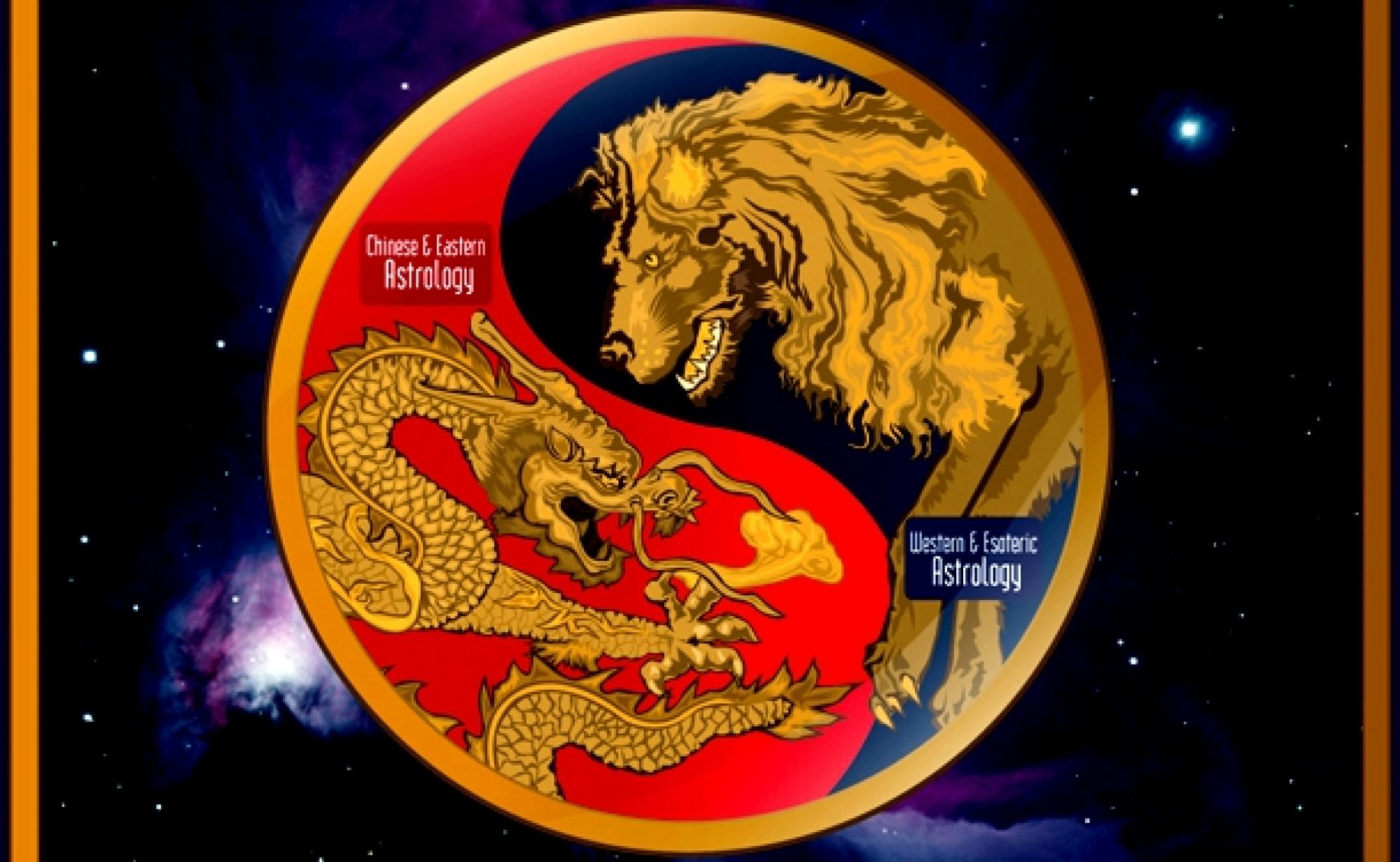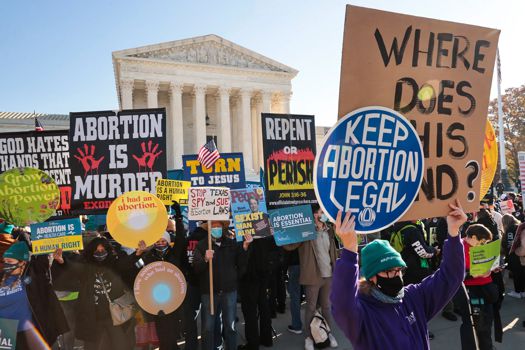Few issues in American society have given rise to such heated and passionate debate as that of abortion. It is an issue about which most people have strong opinions, for or against and entrenched. There appears to be no middle ground, at least in the US, where abortion is seen as murder by opponents and a woman’s sacred right to choose for its adherents. Roe vs. Wade was the landmark decision that decided in favor of women’s rights in 1973. Now, in a recently leaked draft decision circulated among the US Supreme Court (SCOTUS) justices, Roe vs. Wade looks set to be overturned. The battle for hearts and minds regarding abortion is on once again. But what is this really all about? Perhaps the US chart can give us some clues.
Before we even start here, this post will not be examining the morality, legality or ethics of abortion. Instead, it is a look at the prevailing trends in the United States and why this issue has raised its head again. From what we will see, the timing of this leak and pending decision tells us quite a bit. We start with this, to give the current context:
“In response to that leak—and further incensed by the U.S. Senate’s subsequent failure to pass the Women’s Health Protection Act, which would affirm abortion rights at the federal level—and other state-level attacks on reproductive rights, pro-choice advocates held actions Saturday in cities nationwide.
The “Bans Off Our Bodies” events included rallies in hundreds of U.S. cities, from major metropolises like Los Angeles to smaller cities like Staunton, Virginia, where medical student and protest attender Aliena Lowell said, “I felt like I couldn’t rightly stand by and do nothing when a very important part of people’s healthcare was at risk.”
Abortion is not a cut and dried matter, much as more fanatical types would like it to be. That fanaticism is especially evident in sections of the American public, both secular and religious. When it comes to abortion there are issues of health – maternal mortality especially – the well-being of the parents (mental and physical), economics, the welfare of the child (once born), spiritual orientation, the efficacy and availability of birth control or not, social pressures, and so on. And every case is different. Who, really, is to judge? That brings us to the reasons for Roe vs. Wade to begin with, starting with the international scale of abortion laws. The latter gives us a bit of context on the issue.
Internationally, abortion laws vary widely between nations. There are only 9 nations in the world where abortion for any reason is illegal. In Europe only Andorra, the Vatican State and Malta prohibit abortion. The Dominican Republic outlawed abortion in 2009 in response to activism by Roman Catholics. Abortion was banned in Nicaragua in 2006, in Honduras in 1997 and El Salvador in 1998 for the same reasons as that of the Dominican Republic. In Africa abortion is illegal in Madagascar. In Asia, abortion is illegal in the Philippines. In most of these nations, since the introduction of the bans, illegal abortions have increased significantly, as well as maternal mortality. In reading of the reasons for the prohibition of abortion, we find religion to be the primary deciding factor, with the Catholic Church being predominant.
In the US, abortion laws have had a history as long as the nation. Only since Roe vs. Wade have abortion laws been federally mandated, overruling states’ laws. More conservative states had typically banned abortions. Religion was again a major factor in the bans. By 1971, just before the Roe vs. Wade ruling, elective abortion on demand was available only in Alaska, California, Washington, D.C., Washington state, Hawaii, and New York. Those were all more liberal jurisdictions. If a woman in any other state needed or elected to have an abortion, she had to travel to one of the aforementioned states to have one. I can remember people having discussions about the matter.
One of the biggest issues about abortion is the health of the woman. Prior to Roe vs. Wade, and in nations that prohibit abortion, illegal and ‘back-alley abortions’ – potentially dangerous medical abortions – took place, sometimes ending in death, or ruining a woman’s ability to have children and often causing serious emotional and physical trauma. Even now women in Texas will travel to Mexico in search misoprostol (a drug that induces abortions) because abortion laws in Texas are some of the most restrictive in the US, even with Roe vs. Wade still in effect. This brings in a bit of astrology.
Abortion is ruled by three planets and two houses – Mars (surgical/medical intervention), Pluto (clandestine and illegal) and Uranus (spontaneous, otherwise known as miscarriage), the 5th house (children) and the 8th house (death). The 8th house is a consideration only if one sees life as beginning at conception. The other and biggest astrological factor in abortion is the Moon – women in general, motherhood, pregnancy and childbirth. Venus is also a factor, involving the law and young women.
The basic arguments against abortions are to preserve the life of the fetus, to protect the life of the mother, to create deterrence against future abortions, and to avoid injuring the mother’s ability to have children. The religious argument against abortion is that life begins at conception, therefore willfully terminating a pregnancy constitutes murder. Evangelical Christianity is a big driver in the current effort to overturn Roe vs. Wade. The other element is political, which we will get to.
Finally, getting to the actual initial ruling in 1973, Roe vs. Wade was a case regarding the constitutionality of Texas abortion laws. It was finally decided on the following basis, on a woman’s right to privacy:
“This right of privacy, whether it be founded in the Fourteenth Amendment‘s concept of personal liberty and restrictions upon state action, as we feel it is, or … in the Ninth Amendment‘s reservation of rights to the people, is broad enough to encompass a woman’s decision whether to terminate her pregnancy.” — Roe, 410 U.S. at 153.
Further:
“The Court reasoned that outlawing abortions would infringe a pregnant woman’s right to privacy for several reasons: having unwanted children “may force upon the woman a distressful life and future”; it may bring imminent psychological harm; caring for the child may tax the mother’s physical and mental health; and because there may be “distress, for all concerned, associated with the unwanted child”.
But the Court rejected the notion that this right to privacy was absolute. It held instead that women’s abortion right must be balanced against other government interests, such as protecting the mother’s health and protecting the life of the fetus. The Court held that the interests were sufficiently compelling to permit states to impose some limitations on pregnant women’s right to choose to have an abortion.”
On the ‘Wade’ (Texas) side of the argument, their ban on abortions was in “…limiting abortion to situations where the mother’s life was in danger…justified because life began at the moment of conception, and therefore the state’s governmental interest in protecting prenatal life applied to all pregnancies regardless of their stage.” Texas used the religious definition of when life begins to justify their ban.
So, the 1973 decision was an issue weighed between a woman’s right to privately (individually) choose her and the potential child’s destinies against an overall societal consideration and definition of when a human life commences and the legal definition of murder. The chart for the US at the time of the ruling on Roe vs. Wade shows the outcome quite clearly. The chart is below (bigger):
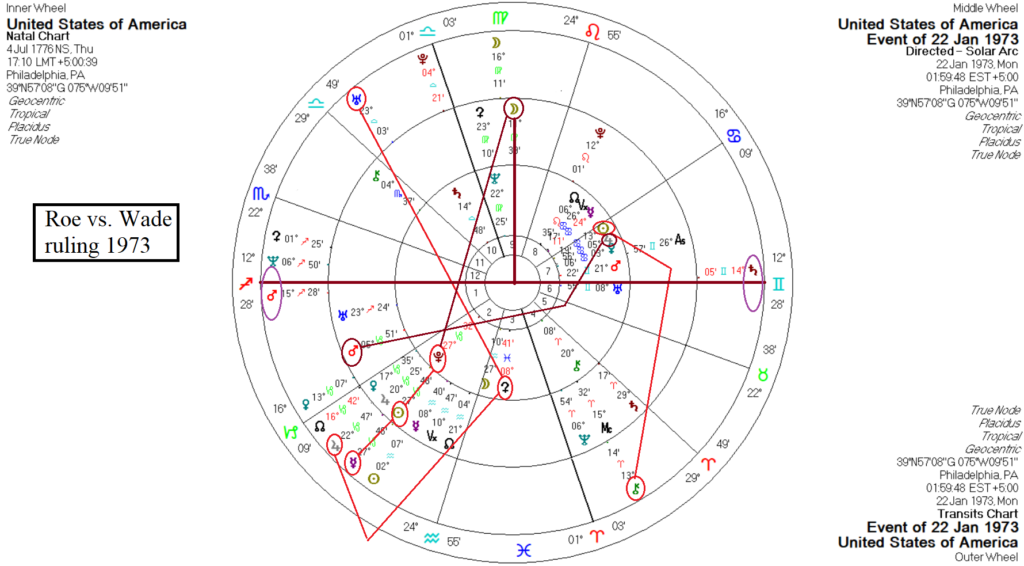
The main feature of the chart is the directed Moon (women) square the US Horizon axis, showing the public mood (1st house) and the litigation/decision (7th house) regarding women (the Moon). Transiting Saturn had just crossed the Descendant, showing the decision, and Mars having just crossed the Ascendant, showing the heightened passions on the issue.
Directed Mars (medical abortions) was almost exact opposite the US Jupiter (Jupiter as the general ruler of judges and judicial matters). Privacy is ruled by the 12th house, and is ruled by Pluto in the case of the US. The directed Sun and transiting Mercury were on the US Pluto on the day, and the directed Moon (in the 9th house of judicial matters and the SCOTUS) was sesquisquare the US Pluto. All the preceding shows the judgement regarding women’s concerns, their right to privacy, a decision on medical abortion (Mars on the US Ascendant opposite transiting Saturn on the Descendant)
The 1973 decision was set in the context of the sexual revolution in the US in the 1960s and 2nd wave feminism in the ‘60s and early ‘70s and the end of the war in Vietnam. There was also the counterculture of the ‘60s and ‘70s that contributed its part to the prevailing public discourse of those decades. The decision also further divided public opinion. As a result of the sexual revolution, feminism and counterculture, we also saw a backlash in the US, like the rise of the ‘religious right’, the ‘New Right’ in US politics and a general conservative backlash. Evangelical Christianity started to enter US politics in a big way around that time.
No sooner had the decision been handed down, then the more reactionary and pro-life factions in the US began seeking ways to dismantle it. One such success was the Hyde Amendment of 1976, a legislative provision barring the use of federal funds to pay for abortion, except to save the life of the woman, or if the pregnancy arises from incest or rape. The amendment was altered several times. Both Biden and Hillary Clinton pledged to overturn it, but failed to do so. In 2017 the House tried to pass H.R. 7, which would have made the Hyde Amendment permanent. That, too, failed. This brings us to the present day.
Why has Roe vs. Wade raised its head again? The current fight for and against a woman’s right to choose/privacy began in earnest after Texas banned abortions after 24 weeks, in a ruling handed down on 1 Sep last year. This challenged the fundamental basis of Roe vs. Wade, in the very state where the original legal battle was based. The decision was appealed, bumped up to the Texas Supreme Court and then subsequently examined twice by the SCOTUS, where it has been upheld:
“The latest development follows a U.S. Supreme Court decision that left the [Texas] ban in place while allowing providers to challenge the law’s unusual enforcement structure. The high court has twice refused to block the Texas law, which makes no exception for rape or incest and is at odds with the landmark Roe v. Wade decision guaranteeing a right to abortion before viability, usually around 23 weeks.”
Basically, in Texas they are back to where they started pre-Roe vs. Wade. Then we find out about the leaked SCOTUS ruling. The pending ruling is as follows:
“We hold that Roe and Casey must be overruled. The Constitution makes no reference to abortion and no such right is implicitly protected by any constitutional provision, including the one on which the defenders of Roe and Casey now chiefly rely-—the Due Process Clause of the Fourteenth Amendment [Section 1]. That provision has been held to guarantee some rights that are not mentioned in the Constitution. But any such right must be deeply rooted in this Nation’s history and tradition” and “implicit in the concept of ordered liberty.”
‘History and tradition’ are concepts inherent in traditional conservatism, reflecting the current composition of the majority of the present SCOTUS justices. Presently, there is a conservative supermajority in the SCOTUS, and they are already showing their teeth. ‘Ordered liberty’ is another conservative talking point, coming to us from the Burkean ‘God-given’ rights of English constitutional monarchy. His ideas hark back to the morality found within the Church, the traditional family and the state. Bolding and brackets added. Continuing:
“…Roe was egregiously wrong from the start. Its reasoning was exceptionally weak, and the decision has had damaging consequences. And far from bringing about a national settlement of the abortion issue, Roe and Casey have enflamed debate and deepened division.
It is time to heed the Constitution and return the issue of abortion to the people’s elected representatives [meaning the individual states]. “The permissibility of abortion, and the limitations, upon it, are to be resolved like most important questions in our democracy: by citizens trying to persuade one another and then voting…That is what the Constitution and the rule of law demand.”
One can read the entire 98 pages of the draft decision at Politico’s site if one is so inclined. There are so many items we could list here where ‘voting’ decides issues in the US (not), but for the pending ruling to state Roe vs. Wade has ‘enflamed debate and deepened division’ and that overturning it would bring about a national settlement of the issue ignores what the state of debate and division was pre-Roe vs. Wade (Casey). Overturning Roe vs. Wade will do nothing to settle the matter and will in fact enflame debate yet again in the US.
There are two main takeaways from these quotes, aside from those just stated. Firstly, the tone reads like the SCOTUS would like to wash their hands of the whole matter and return the decision-making back to the states. Secondly, there is the issue of ‘states’ rights’, which is a favored rallying cry largely by Republicans, though not solely by them, as follows:
“…all rights and powers not specifically reserved to Congress by Article I, Section 8, of the Constitution or to be shared concurrently by the federal and state governments are reserved by either the states or by the people. In order to prevent the states from claiming too much power, the Constitution’s Supremacy Clause (Article VI, Clause 2) holds that all laws enacted by the state governments must comply with the Constitution, and that whenever a law enacted by a state conflicts with a federal law, the federal law must be applied.”
The latter bolded point sidestepped Roe vs. Wade shortly after the 1973 with the Hyde Amendment. What we have with the states’ rights argument has become a dog whistle political issue, especially since the 1960s. It has largely been centered around segregation, same-sex marriage and reproductive rights. And it is mostly the so-called ‘red’ states in the US who favor less federal regulation on such matters and who tend to be more conservative in their politics. A map shows this quite clearly:
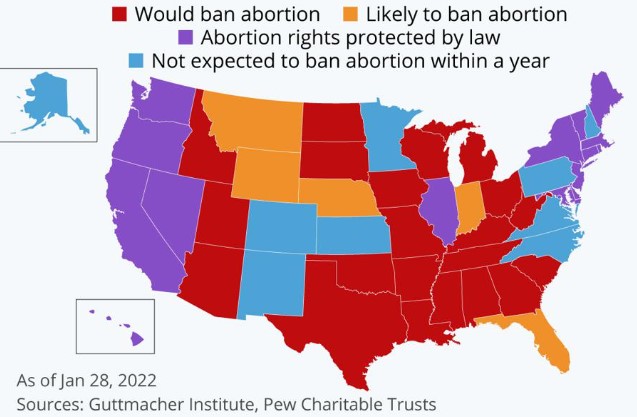
The states that would keep abortion laws are traditional Democrat strongholds. The states that would ban abortion are the ‘flyover states’ (the states between the coastal states) and the states of the Bible Belt where evangelical Christianity is strong, with the exception of North Carolina and Virginia. Those latter two are the battleground states on the abortion issue. Knowing this we are prompted to look at the timing of events and the growing tensions within the US.
Roughly 75% of the American public is dissatisfied with the direction the nation has taken in general, across a raft of issues. Satisfaction levels fell below 50% at the start of the Iraq War (2003) and have not risen above 40% since, except for a few months after Biden was elected. In that we see there is a general and bipartisan disapproval among the American public that has not changed much for the past 20 years. The lowest point was during the 2008 financial crash. At the moment, Republicans are particularly disgruntled with the direction of the nation, and they are hungry for change.
The midterm election cycle is about to start, as in campaigning. Democrats know they need a big ticket issue to push them over the line in order to keep control of the Legislative Branch of government. At the moment their chances of doing so look dim. The war in Ukraine was supposed to boost Biden’s ratings and hasn’t, the economy is tanking, inflation and costs are rising, the NYSE is looking increasingly unstable and is down sharply from the start of the year. Of course, all of that has been ‘baked into the cake’ for years and has been bipartisan, but Biden will take the fall for it.
The preceding is not a good look for an administration that hangs on to power (short of becoming lame duck) by only a slim margin. And what is one of the issues that will rally a Democrat voter base? – abortion rights. The leak of the draft ruling by the SCOTUS appears to have a political component and the US chart with directions and transits (below, bigger) confirms it:
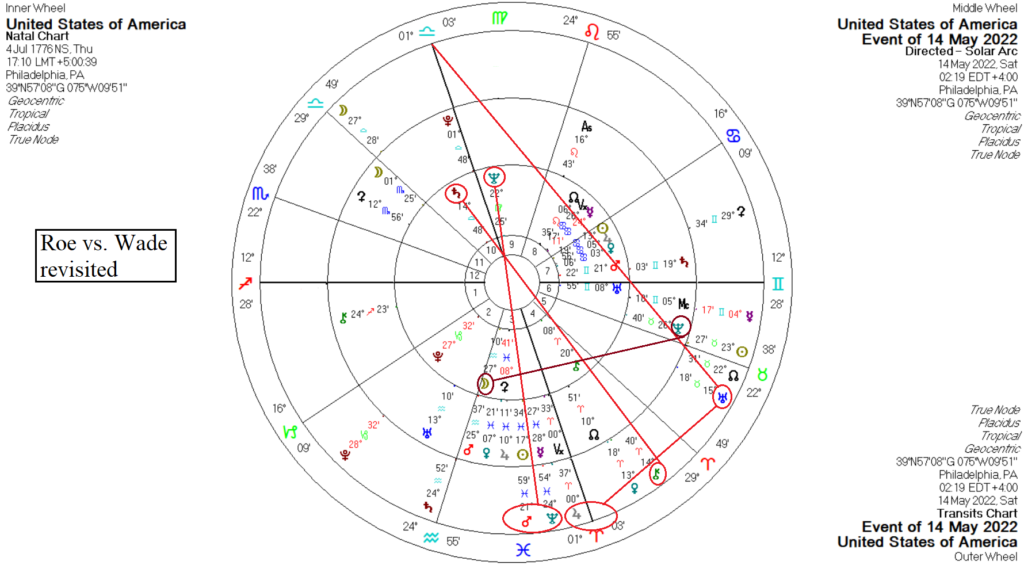
Transiting Uranus at the time of the leak was in the US 5th house (children) sesquisquare the MC, showing a sudden or unexpected shift in fortunes or attitudes. At the same time transiting Jupiter is conjunct the IC, showing a gain in public support. Democrats overwhelmingly support abortion rights. Conservative Republicans in general do not. Moderate Republicans show about 60% support for abortion. Evangelical Christians and Mormons, who generally are Republican voters as well, overwhelmingly reject abortion. Religiously, the more secularly one leans, the greater the support for abortion.
The transits to the US chart now show a boost for Democrats. But at the time of the midterms the progressed Moon forms the apex of a ‘Finger of the World’ pattern with the natal Sun and Saturn of the US, showing a disappointment for women and a more somber mood in the populace in general. However, that could well mean a rallying call for women into the future. But there would be many reasons for a darker mood, inflation being a major one, and that will be on the increase at the midterms. Economic woes spell trouble for any administration at elections.
The midpoint structure for the Finger of the World reads as follows, from Ebertin:
Moon=Sun/Sat: Emotional depressions partly in connection with organic disturbance, emotional inhibitions, fear, feelings of inferiority. – Increasing loneliness, the separation of females, a bereavement.
With all the preceding, we come to the brass tacks of why this pending ruling has come up again: It is about power and staying in power. There is nothing at all in the above chart for the US at the moment that speaks of women’s rights. It is about the sitting government. If/when the SCOTUS pronounces Roe vs. Wade dead and buried, as looks likely, the debate will start all over again. Conservatives and religious conservatives will celebrate the ruling, but their happiness will be short-lived. And the reason for that lies in the very heart of human nature.
The fact is, and history has shown that if a woman wants or needs an abortion, she will have one, whether legal or not, whether safe or not. If the ruling overturns five decades of abortion rights, ‘abortion tourism’ will rise sharply, as well as maternal mortality. And public sentiment, from the polling stated above, shows that abortion rights are not going away, that the majority of the American public wants some measure of protection for a woman’s right to choose.
If Roe vs. Wade is overturned, though, America will be aflame, with state vs. state, with women having to take time off work to travel, waiting days in strange towns with little support (if any), facing hostile anti-abortion activists while entering abortion clinics, all the while being called a murderer, facing financial hardship, not to mention the psychological strain of having had to make the decision in the first place. I have known a few women who have had to make such a choice and it is never made lightly. Overturning Roe vs. Wade will create a media and emotional storm across a nation that needs to be focused instead on matters no less important, like how to feed and house a growing sector of the populace, for one.
The choice to have a child or not is one of the most important and intimate decisions a woman makes in her life. It is a choice made between hers and all the souls involved, not by nine people in dark gray robes, not by religious pronouncement, not by government edict. At present there is no consensus on when a human life begins, when a soul takes hold of a fetus. Who is anyone to make that judgement, except for the potential mother? A woman’s right to choose regarding childbirth is the consensus of all but nine of the nations in the world – the vast majority of the world’s population. That should tell us something.
Featured pic from The New Yorker
